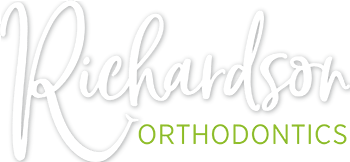Traditional Braces – Richardson, TX
The Trusted Solution for
Straightening Teeth
Whether someone has crooked, crowded, or gapped teeth (or all of the above!), traditional braces in Richardson, TX can be relied on to create a perfectly straight and functional smile. While Dr. Jones and Dr. Amerson often recommends them for younger patients, they’re able to help a lot of adults as well who have more severe orthodontic issues. Thanks to her experience as a board-certified orthodontist, you can trust that you or your child’s treatment process will be smooth, comfortable, and end with gorgeous results. To get started on the road to a new smile, we invite you to schedule a FREE consultation today.
Why Choose Richardson Orthodontics for Traditional Braces?
- Only Female Board-Certified Orthodontist in Richardson
- 16 Years of Experience Creating Winning Smiles
- Dental Insurance Accepted, 0% In-House Financing
Braces Basics

You probably saw many of your peers with braces growing up, and they still basically work the same way these days! Two wires placed along each row of teeth are used to apply slight pressure to move them into their desired positions. To keep these wires in place, they are attached to brackets that are bonded to each tooth. While braces of the past were notoriously bulky and irritating, today’s braces are much smaller and more subtle-looking, but they are still as effective as ever.
The Benefits of Braces

When people think of braces, many consider them to be a purely cosmetic treatment. While straightening the teeth can certainly improve someone’s appearance, this isn’t the limit to their potential benefits. Straighter teeth also tend to be healthier teeth!
When the teeth are crowded and crooked, this can create small, hard-to-brush spaces where plaque and bacteria can become trapped and eventually cause cavities. Properly aligned teeth are much easier to clean, meaning orthodontics can actually dramatically lower someone’s risk for both cavities and gum disease!
In addition to the teeth, braces can also help correct a misaligned bite. Once again, in addition to enhancing someone’s appearance, this can also help with their oral function. When the bite comes together as it should, actions like eating and speaking become much more comfortable. This can also prevent and/or fix pain related to a strained jaw joint, which may be the underlying cause of headaches and neck aches as well.
And lastly, braces can also provide a reliable confidence booster. Feeling self-conscious about crooked teeth and a less than perfect smile can weigh heavily on someone regardless of their age. But, once the braces come off and a patient’s new smile is revealed, our team can instantly see the change in someone. When a patient feels great about their teeth, they are more likely to engage socially and feel comfortable around new people, which can be tremendously helpful for both children and adults!
Customizable Brackets

With traditional braces, patients have a little room to add their personality into their treatment. The rubber bands used to hold the wires in place come in a rainbow of colors, and they are switched out every few weeks at adjustment/progress appointments. This means a child can choose their favorite color or even have their braces match the season or their school! For adults, we can provide clear or white elastics so the braces easily blend into the smile.
Understanding the Cost of Traditional Braces

The cost of traditional braces will vary from patient to patient, as there are many different variables that come into play. At Richardson Orthodontics, we can outline your treatment costs during your initial consultation as well as go over your financial options. In the meantime, here are some things to take into consideration.
Factors That Affect the Cost of Traditional Braces

The cost of braces will vary depending on numerous different factors. Here are some of the most prominent:
- Severity of misalignment – The greater distance the teeth need to move, the longer treatment will generally take.
- Length of your treatment –In many cases, the longer you wear braces, the higher your treatment costs, as you’ll require more routine checkups, adjustments, and supplies.
- Your age – As an adult, your teeth are more firmly set in your jawbone than they were during childhood and adolescence. They take more time to move, so your treatment may cost slightly more.
- Number of follow-up appointments needed – Throughout treatment, braces need to be adjusted/tightened every two to eight weeks depending on the patient’s progress and needs.
- Other orthodontic devices/appliances needed – Most patients with braces also need to wear other supplies, such as space maintainers, palatal expanders, elastics, headgear, and retainers.
- Compliance with treatment guidelines – For example, if you need to wear rubber bands on your braces, but you fail to do so often enough, your teeth won’t move as planned. Therefore, your treatment will probably take longer.
Professional Braces vs. “DIY” Braces: Which Costs More?

It can be tempting to try to save money by opting for a “do-it-yourself” approach. There have been numerous recent trends of people trying to straighten their teeth using a variety of household and over-the-counter items, including fishing lines, earring backs, superglue, rubber bands, and more. While these items may sound like they can do the job, they are likely to cause serious issues that will need to be addressed by an orthodontist. This can ultimately spell disaster for your wallet.
Without the guidance of a dental professional, you could accidentally shift your teeth in the wrong direction, throw off your jaw alignment, and damage the soft tissues in the mouth. Ultimately, you could end up with some serious issues that will need to be corrected. By seeing your dentist for traditional braces from the start, you can save your wallet!
Does Dental Insurance Cover Braces?

Some dental insurance plans include coverage for orthodontic treatment. It is more likely that they will be covered if you need them for a medical reason, like a misaligned jaw or difficulty chewing. Additionally, some plans only cover braces for patients under the age of 18. If your insurance does cover braces, you can generally expect up to 50% coverage, but this can vary from plan to plan. You should check with your insurance provider ahead of time so you know what you can expect.
Options for Making Braces Affordable

Whether you do or don’t have dental insurance, there is no need to stress about one giant payment. Instead, you can apply for in-house financing. This way, the cost can be broken into smaller, more manageable monthly payments. Talk to one of our friendly team members to learn more!
To find out exactly how much you can expect your orthodontic treatment to cost, schedule a consultation with us. We’re eager to help you achieve a straighter smile.
Traditional Braces FAQs

At Richardson Orthodontics, Dr. Jones and Dr. Amerson and her team are dedicated to ensuring the success of your child’s orthodontic treatment. While preparing for life with braces may seem a bit overwhelming, we are here to keep you and your child ready and informed about the expectations before, during, and after treatment. Below you will find a list of common questions asked by patients that we hope you will review. If you do not see your question listed or would like to inquire further about your child’s individual plan, contact us to schedule an appointment today.
Is there an ideal age for a child to start wearing braces?
It is recommended that all children receive an orthodontic evaluation at the age of 7. This will allow an orthodontist to review their oral cavity and facial structures to determine if there are any problems occurring that might affect their teeth or bite. If braces are required, it is not uncommon for children to start treatment around the age of 11 or 12, but it can start much earlier (around 8) if the orthodontist believes it is necessary. The earlier you can begin to treat your child’s crooked or gapped teeth, the longer-lasting the results will be as their bones are still developing, making it easier to complete orthodontic treatment.
How can my child relieve soreness from braces?
Discomfort is a common symptom that occurs while wearing braces. It is often most obvious at the start of treatment as well as when the wire needs to be tightened or adjusted during follow-up appointments. To mitigate the pain level for your child, it is advised that you give them an over-the-counter pain reliever (i.e., ibuprofen), offer a cool beverage, or use a cold compress. This is only temporary and should dissipate within a few days.
Which foods should my child avoid?
Eating with braces is a bit tricky, which is why you’ll want to make sure your child is consuming the right foods. If you want to prevent an orthodontic emergency, help your child avoid:
- Nuts
- Popcorn
- Sticky or hard candy
- Whole apples
- Corn on the cob
- Hard bread
- Raw vegetables (i.e., carrots)
Too much pressure applied to brackets and wires can cause them to break, become loose, or poke out, causing irritation to your soft oral tissues.
How should my child take care of their teeth while wearing braces?
A few helpful tips by your child’s pediatric orthodontist can ensure their smile looks and feels its best while undergoing orthodontic treatment:
- Have them brush their teeth after every meal and floss at least once (preferably before bed)
- Make sure they’re using fluoride toothpaste to help strengthen tooth enamel and combat cavities
- Continue to schedule their six-month dental checkups and cleanings while wearing braces, as this will allow their dentist to ensure no problems are developing that could cause a delay in treatment
- Have them avoid sticky, sugary foods that can become easily stuck or cause damage to their oral appliances
How long will it be necessary for my child to wear a retainer after finishing treatment with braces?
It depends on your child’s case as to how long they can expect to wear a retainer; however, Dr. Jones and Dr. Amerson will likely recommend that this oral appliance be worn full time until the bite becomes permanent. This will mean wearing the retainer all day, every day for a while but once their teeth become permanently affixed into place, they may only be required to wear it at night while they sleep. Ultimately, the process will be based on your child’s smile and what it needs to prevent their teeth from shifting back into their original position.
Will braces interfere with my child being able to play sports or a particular instrument?
While wearing braces, your child may need to inquire about having a customized mouthguard created. These oral devices make it possible to protect teeth, gums, and oral appliances while out on the field, court, or track. The important thing to remember is that while your child may need to adjust to wearing braces, it shouldn’t cause them to feel the need to give up their favorite activities, which can most certainly be enjoyed during this time.
Will insurance cover the cost of my child’s orthodontic treatment?
There is a good chance that your dental insurance company will agree to pay a portion of your child’s orthodontic treatment, but if you are unsure, our team will be happy to work on your behalf to help you get the answers you need. As an insurance-friendly orthodontic practice, Dr. Jones and Dr. Amerson are in-network with many available insurance plans. We are also pleased to offer in-house financing should you need assistance in paying the remaining balance.

